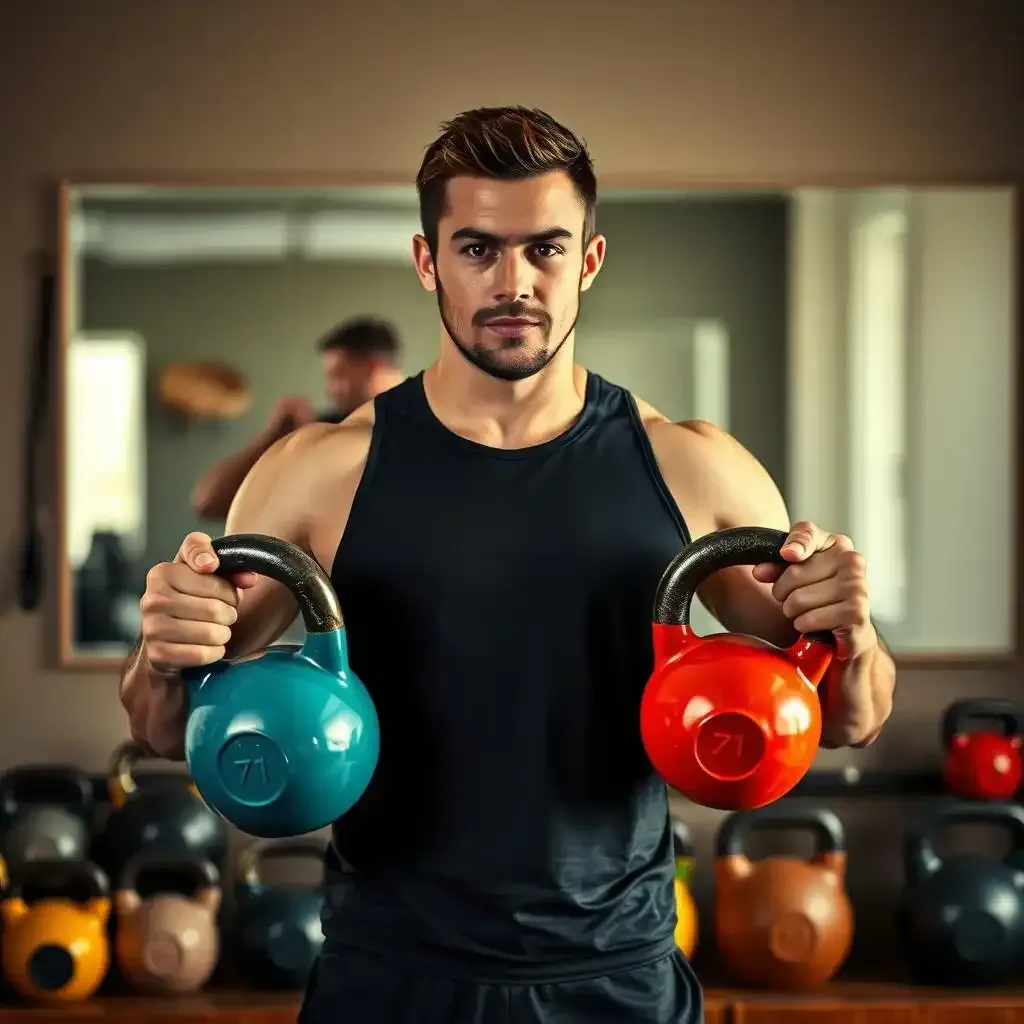Table of Contents
Are you looking for a way to spice up your workout routine and take your fitness trip to the next level? Look no further than kettlebell workout equipment! At kettlebellworkout.kettlebellworkout.com, we believe that kettlebells are an essential tool for any serious fitness enthusiast. In this article, we'll explore the benefits of using kettlebell workout equipment, help you choose the right kettlebell for your needs, and provide you with tips on how to incorporate kettlebells into your workout routine. So, whether you're a seasoned athlete or just starting out on your fitness trip, keep reading to uncover the strength of kettlebell workout equipment!
Benefits of Using Kettlebell Workout Equipment in Your Fitness Routine

Benefits Of Using Kettlebell Workout Equipment In Your Fitness Routine
Kettlebells are an excellent addition to any workout routine, offering a full-body exercise that can help improve strength, flexibility, and cardiovascular health. One of the primary benefits of using kettlebells is their ability to target multiple muscle groups simultaneously, making them a time-efficient way to work out. Whether you're a seasoned athlete or just starting out on your fitness process, kettlebells can be an effective tool for achieving your goals. You can read more about beginner kettlebell routines here.
Another advantage of kettlebells is their versatility. They can be used for a wide range of exercises, from swings and squats to presses and rows. This variety makes it easy to incorporate kettlebells into your existing workout routine or use them as a standalone tool for strength training. Additionally, kettlebells are often more affordable than other types of exercise equipment, making them a great option for those on a budget. Be sure to check out our article on kettlebell exercises for beginners for more information.
- Full-body exercise
- Time-efficient
- Versatile
- Affordable
- Targets multiple muscle groups simultaneously
When it comes to choosing the right kettlebell, there are several factors to consider. The weight of the kettlebell will depend on your fitness level and the specific exercises you plan to use it for. It's also important to consider the material and design of the kettlebell, as some may be more comfortable or durable than others. Check out our article on kettlebell weight guide for more information.
Overall, kettlebells are a valuable addition to any workout routine. They offer a full-body exercise that can help improve strength, flexibility, and cardiovascular health, making them an excellent choice for anyone looking to get in shape. Be sure to check out our article on kettlebell exercises simple...
Type of Kettlebell | Weight Range | Material |
|---|---|---|
Cast Iron Kettlebell | 5-80 lbs | Cast iron |
Rubber Coated Kettlebell | 5-50 lbs | Rubber coated steel |
Competition Kettlebell | 8-32 kg | Steel |
...
Choosing the Right Kettlebell Workout Equipment for Your Needs

Choosing The Right Kettlebell Workout Equipment For Your Needs
So, you're thinking about joining the kettlebell crew? Awesome! But before you grab the first one you see, let's chat about choosing the right kettlebell for *you*. It's like choosing a pair of shoes – you wouldn't wear running shoes for hiking, right? Think about your fitness level and what you hope to achieve. Are you a total beginner? Then start with a lighter kettlebell; you don't want to hurt yourself before you even get started! Check out our kettlebell basics guide for some great starting points.
I remember when I first started, I was so excited I almost grabbed the heaviest kettlebell I could find. Big mistake! I ended up struggling with my form and almost pulled a muscle. Start small, my friend! Gradually increase the weight as you get stronger. It's all about building a solid foundation. We've got some great tips for newbies on our kettlebell for newbies page.
- Consider your fitness level
- Start with a lighter weight
- Gradually increase weight
- Prioritize good form over heavy weight
Next, think about the material. Cast iron kettlebells are super durable and usually cheaper. But if you're working out on a hard floor, a rubber-coated one will be kinder to your floors and your ears! They're less noisy. And for those serious lifters aiming for competitions, you’ll want a competition-style kettlebell. They’re designed for heavy lifting and are built to last.
Don't forget about adjustable kettlebells! These are like having a whole set in one! They're super convenient, especially if you're short on space. But remember, they might not always feel exactly the same as a solid kettlebell. For a deep explore into different kettlebell types and weights, check out our kettlebell weight guide.
Kettlebell Type | Pros | Cons |
|---|---|---|
Cast Iron | Durable, Affordable | Can be noisy, may damage floors |
Rubber Coated | Quieter, Floor-friendly | More expensive |
Adjustable | Convenient, Space-saving | May not feel like a solid kettlebell |
Finally, consider where you’ll be using your kettlebell. If you're working out at home, you might want to think about storage space. If you're going to the gym, portability might not be as important. And remember, safety first! Always make sure you have enough space around you to swing that kettlebell without knocking anything over (or worse, yourself!).
Choosing the right kettlebell might seem overwhelming at first, but by thinking about these factors, you'll find the perfect one to help you achieve your fitness goals. Need even more help? Check out our kettlebell for fitness beginners article for more tips and tricks!
Incorporating Kettlebell Workout Equipment into Your Workout Routine

Incorporating Kettlebell Workout Equipment Into Your Workout Routine
Getting Started: Kettlebell Exercises for Beginners
Okay, so you've got your kettlebell – congrats! Now what? Don't jump into crazy complicated moves right away. Think of it like learning to ride a bike – you wouldn't try a wheelie on your first go, would you? You start with the basics. For beginners, I recommend focusing on fundamental movements that build a strong base. Think kettlebell swings (they're amazing for your whole body!), goblet squats (great for leg strength), and simple rows (works your back and arms beautifully). Check out our kettlebell exercises for starters guide for some easy-to-follow videos and instructions. Remember, proper form is key – it's better to do fewer reps with perfect form than lots of reps with sloppy form. Sloppy form leads to injuries, and nobody wants that!
I started with just a 10-pound kettlebell, and honestly, it was challenging enough! Don't underestimate the ability of a lighter weight. It's all about building strength and mastering the movements. Once you feel comfortable with the basics, you can gradually increase the weight and explore more advanced exercises. We have tons of beginner routines on our site, perfect for building that solid foundation. Take a look at our beginner kettlebell workouts page for some ideas! Trust me, consistency is far more important than intensity, especially when you’re just starting out.
- Start with basic exercises: swings, squats, rows
- Focus on perfect form
- Gradually increase weight as you get stronger
- Consistency is key!
Adding Kettlebells to Your Existing Routine
Already got a workout routine you love? Awesome! Integrating kettlebells doesn't have to be a total overhaul. You can easily incorporate them into your current schedule. For example, if you already do squats, try adding kettlebell goblet squats. If you do bicep curls, try some kettlebell bicep curls. The possibilities are endless! Just remember to listen to your body. If something feels wrong, stop immediately. We have a whole section on kettlebell safety tips to keep you safe and injury-free.
One thing I really like to do is replace some of my usual exercises with kettlebell variations. For instance, instead of doing regular push-ups, I'll do Turkish get-ups (they're a challenge, but they're amazing!). You can also use kettlebells for cardio – try kettlebell swings or burpees with a kettlebell. It's a great way to mix things up and keep your workouts exciting. Check out our easy kettlebell exercises page for some fun ideas to incorporate into your existing routine.
Exercise | Kettlebell Variation | Benefits |
|---|---|---|
Squats | Goblet Squats | Increased core engagement, improved balance |
Bicep Curls | Kettlebell Bicep Curls | Improved grip strength, full range of motion |
Push-ups | Turkish Get-ups | Full-body strength, improved coordination |
Tips for Getting the Most Out of Your Kettlebell Workout Equipment

Tips For Getting The Most Out Of Your Kettlebell Workout Equipment
Alright, so you've got your kettlebell and you're ready to rock. But how do you really get the most out of it? Let’s examine in with some practical tips that will help you maximize your kettlebell workouts.
First things first, consistency is key. It’s like planting a garden. If you water the plants once and expect them to grow overnight, you’re in for a disappointment. Similarly, if you use your kettlebell once and expect to see results, it’s not going to happen. Stick with it and make kettlebell workouts a regular part of your routine. For some fun beginner routines, check out our .
- Consistency is key
- Start with a plan
- Focus on form
Next, start with a plan. Having a structured workout plan can make a huge difference. It’s like having a map when you’re on a road trip. Without a map, you might wander around aimlessly. With a plan, you know exactly where you’re going and how to get there. Whether you’re a beginner or an advanced lifter, having a clear plan helps you stay on track. For some great kettlebell workout plans, check out our kettlebell workout plan page.
Now, let’s talk about form. Proper form is crucial to avoid injuries and get the most out of your workout. It’s like learning to ride a bike. You can pedal as hard as you want, but if you’re not pedaling correctly, you won’t go very far. The same goes for kettlebell exercises. Take the time to learn the correct form for each exercise. If you’re not sure, there are plenty of resources available. For a detailed form guide, check out our kettlebell form guide.
Exercise | Common Mistake | Correct Form |
|---|---|---|
Kettlebell Swing | Rounding the back | Keep your back straight |
Goblet Squat | Letting knees collapse inward | Keep knees tracking over the toes |
Overhead Press | Using too much momentum | Control the movement |
Finally, listen to your body. It’s like a car that needs regular maintenance. If you ignore warning signs, you’ll end up with a major breakdown. If you feel pain or discomfort during a kettlebell exercise, stop and reassess. Maybe you need to adjust your form or use a lighter weight. Don’t push through pain—listen to your body and make adjustments as needed. For some safety tips, check out our page.
So, there you have it. Consistency, planning, form, and listening to your body—these are the keys to getting the most out of your kettlebell workout equipment. Stick with these tips, and you’ll be well on your way to achieving your fitness goals. Happy lifting!
Final Thought
In conclusion, kettlebell workout equipment is a versatile and effective tool for strength training and full-body exercises. By choosing the right kettlebell for your needs and incorporating it into your workout routine, you can open up a world of fitness possibilities. Visit kettlebellworkout.kettlebellworkout.com today to explore our selection of kettlebells and start achieving your fitness goals!